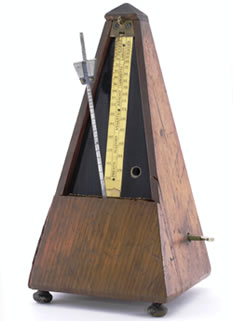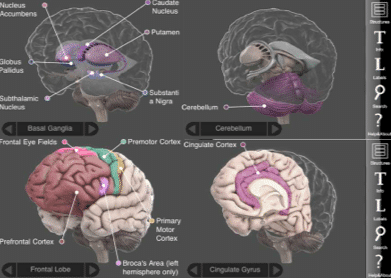Is the P-FIT it? Part 1: The P-FIT model described
The law of individual differences is the only proven law in psychology. This law has resulted in decades of research regarding theories and models of intelligence and individual differences in intelligence. Within the past two decades a general consensus has emerged from the psychometric intelligence research that the Cattell-Horn-Carroll (CHC) theory of intelligenceis the most empirically supported taxonomy for understanding the structure of human intelligence.
[Note – this is the first in a series of posts intended to present an integration of intelligence, cognitive neuroscience, and applied neuroscience research with the goal to advance a set of hypotheses or model(s) that explain how the Interactive Metronome ® (IM) technology results in improved cognitive functioning specifically focus or controlled attention]
IM-Home blog posts by Dr. Kevin McGrew (Volume 1: 6-3-12)
Time Travels with the Time Doc: Trip 1: Quieting the Busy Mind
I have been blogging about brain-clock research at my home base for many years and more recently have been blogging at the IM-Home website and blog. A problem with sharing information via blogging is that we bloggers make desired connections via hyperlinks. We insert them so the reader will read prior posts for related or background information. Often readers don’t want to take the time to bounce back and forth between linked stories…
A Bit of Research: The important of timing in Speed Skating and the use of the Interactive Metronome
The important of timing in Speed Skating and the use of the Interactive Metronome
 Researchers at Korea University College of Medicine (Park et al, 2012) recently conducted a neural imaging study of elite speed skaters to investigate whether training of complex motor skills resulted in structural changes to the cerebellum. The cerebellum responds to intense, repetitive training with increased brain mass in areas critical for skilled motor movement, in this case for control of balance, precisely coordinated movement, and visually guided movement. The authors compared the cerebellums of professional speed skaters to individuals who did not engage in regular exercise. They found that the specific skills required for speed skating that were trained repetitively resulted in structural changes to the brain that enhanced balance and coordination. They also found that the particular side of the cerebellum that was exercised repeatedly was affected (i.e., the right side due to maintaining balance on the right foot during turns). Of note, the cerebellum is also a central part of the brain’s internal timing network. The timing and synchronization of neural signals ultimately controls balance and coordination…
Researchers at Korea University College of Medicine (Park et al, 2012) recently conducted a neural imaging study of elite speed skaters to investigate whether training of complex motor skills resulted in structural changes to the cerebellum. The cerebellum responds to intense, repetitive training with increased brain mass in areas critical for skilled motor movement, in this case for control of balance, precisely coordinated movement, and visually guided movement. The authors compared the cerebellums of professional speed skaters to individuals who did not engage in regular exercise. They found that the specific skills required for speed skating that were trained repetitively resulted in structural changes to the brain that enhanced balance and coordination. They also found that the particular side of the cerebellum that was exercised repeatedly was affected (i.e., the right side due to maintaining balance on the right foot during turns). Of note, the cerebellum is also a central part of the brain’s internal timing network. The timing and synchronization of neural signals ultimately controls balance and coordination…
ADHD as a brain network dysfunction: IM as a tool to “fine tune” and control this network.
Why Can’t I use a Regular Metronome?
Why Can’t I use a Regular Metronome?
 Some parents have asked me if they could just use a regular musical metronome and get the same results as Interactive Metronome at home or IM-Home. A standard metronome is typically used by musicians to help them practice the tempo of music. They have also been used in traditional therapy to help patients with their timing and rhythm, however there is one piece that is missing. – FEEDBACK!
Some parents have asked me if they could just use a regular musical metronome and get the same results as Interactive Metronome at home or IM-Home. A standard metronome is typically used by musicians to help them practice the tempo of music. They have also been used in traditional therapy to help patients with their timing and rhythm, however there is one piece that is missing. – FEEDBACK!
Does IM really help with ADHD?
Dr. Stanley Greenspan, a noted expert in autism and child development/disorders, and his team of researchers conducted a study to see whether Interactive Metronome (IM) was a beneficial treatment for children with ADHD. They compared boys who received IM to boys who received either no treatment at all or boys who only played video games to try to improve their ability to focus. They found that those children with ADHD who received IM did far better than those that did not, with significant improvement in the areas of attention, motor skills, language processing, reading, and self-control (i.e., less aggressive behavior).
Timing influences Auditory Processing and Speech
 Timing skills play a pivotal role in the development of speech production and perception, or the ability to speak and understand the speech and/or intent of others (Kello, 2003). Not only must a child rapidly decipher the timing characteristics of each individual sound, syllable, word, and phrase in the speech stream, but for successful communication to occur there must be precisely timed coordination between centers of the brain for language and cognitive processing or thinking skills and the muscles and structures of the mouth and throat (or voice box). On top of that, a child must process and understand other information associated with what is said, such as demeanor of the person (Is he happy? Angry? Sad? ) or humor (Was he serious? Or was he joking?) Many children on the Autism Spectrum either don’t understand what you said, or don’t understand the unspoken social aspects of speech. All of this depends upon timing in the brain!!! That’s a bit like patting your head and rubbing your tummy at the same time! However, in normal development the brain’s “internal clock” functions very precisely so that children learn to speak intelligibly and understand you when you speak to them, including your mood and intent. Interactive Metronome (IM) training impacts the very critical timing centers of the brain necessary for effective communication & social skills.
Timing skills play a pivotal role in the development of speech production and perception, or the ability to speak and understand the speech and/or intent of others (Kello, 2003). Not only must a child rapidly decipher the timing characteristics of each individual sound, syllable, word, and phrase in the speech stream, but for successful communication to occur there must be precisely timed coordination between centers of the brain for language and cognitive processing or thinking skills and the muscles and structures of the mouth and throat (or voice box). On top of that, a child must process and understand other information associated with what is said, such as demeanor of the person (Is he happy? Angry? Sad? ) or humor (Was he serious? Or was he joking?) Many children on the Autism Spectrum either don’t understand what you said, or don’t understand the unspoken social aspects of speech. All of this depends upon timing in the brain!!! That’s a bit like patting your head and rubbing your tummy at the same time! However, in normal development the brain’s “internal clock” functions very precisely so that children learn to speak intelligibly and understand you when you speak to them, including your mood and intent. Interactive Metronome (IM) training impacts the very critical timing centers of the brain necessary for effective communication & social skills.
Kello, C.T. (2003). Patterns of timing in the acquisition, perception, and production of speech. Journal of Phonetics, 31, 619-626.



